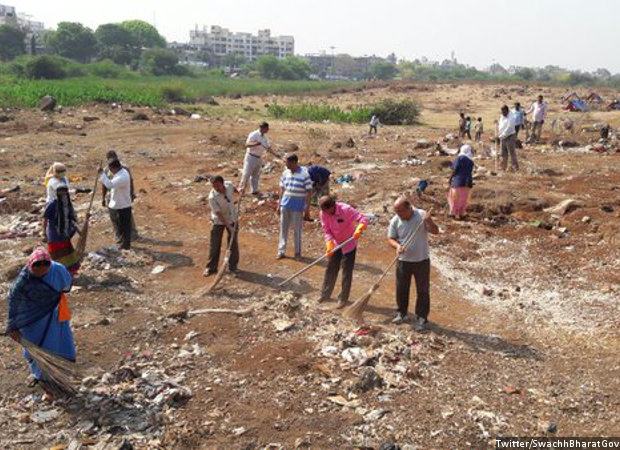Swachh Bharat Mission Fails March 2016 Urban-Trash Targets
Cleanliness drive in Pune as part of the Swachh Bharat Mission.
No more than 17.6% of urban solid-waste (garbage) was processed as of March 2016, against a target of 30%, set last year under the Swachh Bharat (Clean India) Mission launched by Prime Minister Narendra Modi.
The Mission's second target, door-to-door trash collection, did better: 42.3% of urban India's garbage was being collected from homes as of March 2016, against a target of 50%.
The government reported progress to Parliament in this answer.
The Swachh Bharat Mission (urban) aims to not just provide sanitation to India's towns and cities—which, as we reported in the first part of this series, has also failed its March 2016 target—but also reduce trash and process it for disposal.
Source: Lok Sabha
Chandigarh processes all its waste, followed by Meghalaya, which processes 58%, and Delhi, 52%. In Chandigarh, waste is collected from every household, and roadside waste is swept up, which means slums are also covered. The collected garbage is then taken to a facility to be separated.
Source: Lok Sabha
None of the five states at the bottom of the waste-processing ladder process urban waste, implying it is dumped. For instance, little appears to have changed in Patna, described in 2008 as the "City of Garbage" by the Patna High Court. The city's waste--when it is collected, much of it is not--is dumped at several sites, and, despite a high-court order, there is no solid-waste management plan.
Chandigarh, Goa collect all household waste from doorsteps
Chandigarh and Goa collect all household waste from homes. After them is much larger Andhra Pradesh, where 90% of urban garbage is collected from doorsteps.
Source: Lok Sabha
The government is monitoring progress of cities and issuing cleanliness rankings. Mysuru leads those rankings currently, as IndiaSpend reported last month, followed by Chandigarh.
In most of the bottom five states, in wards where there is no garbage collection, trash often ends up on the streets or festers in randomly chosen dumps.
Source: Lok Sabha
Only 3% of Uttar Pradesh's urban wards--the state is India's largest by population--have garbage-collection facilities, prompting a notice from the National Green Tribunal to the UP government for the poor waste management.
At the national level, 64.2% wards were found to have a dumping place for solid waste, according to the Swachhata Status report released by the national Sample Survey Organisation. This means more than 35% of India does not even have waste dumps, let alone processing ability.
Can India become clean, as Swachh Bharat hopes, by 2019?
Urban India, home to 377 million people, generates 62 million tonnes of garbage daily, making India the world’s third-largest garbage generator, after China and the US.
However, it’s not the amount of waste generated that’s as much of an issue as the fact that more than 45 million tonnes, or 3 million trucks worth, of garbage is untreated and disposed of by municipal authorities daily in an unhygienic manner leading to health issues and environmental degradation, IndiaSpend reported in 2014.
These 3 million trucks, laid end to end, would wind their way around India's land borders and coastline.
With rapid urbanisation, industrialisation and an explosion in population in India, solid-waste management is a key challenge for state governments and local municipal bodies.
The Swachh Bharat Mission was launched on 2nd October 2014, on Mahatma Gandhi’s birth anniversary; its target completion date is 2019, Gandhi’s 150th birth anniversary.
Update: This article was based on a question answered in the Lok Sabha on December 09, 2015. The same question was asked again on April 27, 2016, and the government released new data:
The Mission's second target, door-to-door trash collection, did better: 87% of urban India's garbage was being collected from homes as of March 2016, against a target of 50%. However, large states, such as UP and Maharashtra (which together account for 25% of India’s urban population) have failed to meet their targets, collecting only 10% and 14%, respectively, of garbage from homes.
| Collecting Trash at Doorstep, Top Five States | ||
|---|---|---|
| State & Cities/towns | 100% Door to Door Collection of Waste | |
| Wards Targetted | Wards Achieved | |
| Chandigarh UT | 13 | 26 |
| Goa | 96 | 192 |
| Gujarat | 869 | 1658 |
| Andhra Pradesh | 1697 | 3072 |
| NCT of Delhi | 136 | 232 |
| Collecting Trash at Doorstep, Bottom Five States | ||
|---|---|---|
| State & Cities/towns | 100% Door to Door Collection of Waste | |
| Wards Targetted | Wards Achieved | |
| Sikkim | 24 | 4 |
| Assam | 444 | 92 |
| Maharashtra | 3527 | 508 |
| Uttar Pradesh | 5645 | 596 |
| Meghalaya | 57 | 6 |
Series concluded. You can read the first part here.
(Salve is an analyst with IndiaSpend.)
We welcome feedback. Please write to respond@indiaspend.org. We reserve the right to edit responses for language and grammar.
__________________________________________________________________
Liked this story? Indiaspend.org is a non-profit, and we depend on readers like you to drive our public-interest journalism efforts. Donate Rs 500; Rs 1,000, Rs 2,000.



